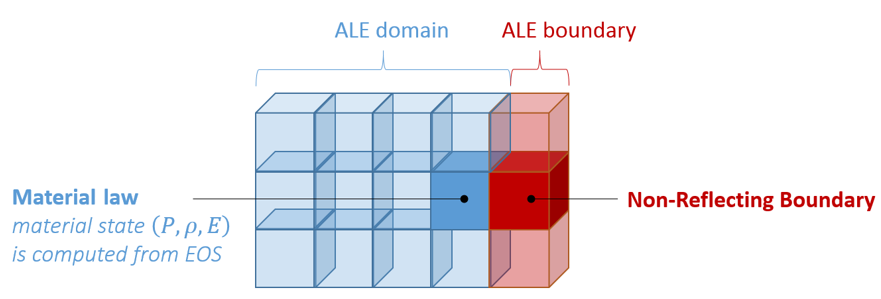Block Format Keyword
/MAT/LAW11 - ITYP=3: Boundary Conditions Material in Flow Analysis.
Description
This law enables to model a non-reflecting boundary (NRF).

Format
(1)
|
(2)
|
(3)
|
(4)
|
(5)
|
(6)
|
(7)
|
(8)
|
(9)
|
(10)
|
/MAT/LAW11/mat_ID or /MAT/BOUND/mat_ID
|
mat_title
|

|

|
|
|
|
|
|
|
Ityp
|
|
Psh
|
|
|
|
|
|
Ityp = 3 - Non-Reflecting Boundary
(1)
|
(2)
|
(3)
|
(4)
|
(5)
|
(6)
|
(7)
|
(8)
|
(9)
|
(10)
|
|
|
c
|
lc
|
|
|
|
|
Blank Format
|
Blank Format
|
Blank Format
|
Blank Format
|
Blank Format
|
Blank Format
|
Field
|
Contents
|
SI Unit Example
|
mat_ID
|
Material identifier
(Integer, maximum 10 digits)
|
|
mat_title
|
Material title
(Character, maximum 100 characters)
|
|

|
Initial density (Comment 3)
(Real)
|

|

|
Reference density used in E.O.S (equation of state)
Default  (Real) (Real)
|

|
Ityp
|
Boundary condition type (Comment 1)
(Integer)
= 0: gas inlet (from stagnation point data)
= 1: liquid inlet (from stagnation point data)
= 2: general inlet/outlet
= 3: non-reflecting boundary
|
|
Psh
|
Pressure shift (Comment 2)
(Real)
|

|
c
|
Outlet sound speed (Comment 1)
(Real)
|

|
lc
|
Characteristic length (Comment 1)
(Real)
|

|
|
| 1. | Non-Reflecting Boundary formulation is based on Bayliss & Turkel [1]. The objective is to impose a mean pressure which fluctuate with rapid variations of pressure and velocity: |

Pressure in the far field P is imposed with a function of time. The transient pressure is derived from P is imposed with a function of time. The transient pressure is derived from P , the local velocity field V and the normal of the outlet facet: , the local velocity field V and the normal of the outlet facet:
| • | density, energy, temperature, turbulent energy and dissipation are imposed with a function of time as in Ityp = 2 |
| • | if the function number is 0, the neighbor element value is used to respect continuity |
| • | acoustic impedance will be  |
| • | typical length lc is used to relax the effective pressure towards its imposed value. It should be large compared to the highest wave length of interest in the problem. The relaxation term acts as high pass filter whose frequency cut-off is:

Where, sound speed c and characteristic length lc are two required parameters (non zero). |
| 2. | The PSH parameter enables shifting the output pressure which also becomes P-PSH. If using PSH=P(t=0), the output pressure will be  , with an initial value of 0.0. , with an initial value of 0.0. |
| 3. | With thermal modeling, all thermal data ( , …) can be defined with /HEAT. , …) can be defined with /HEAT. |
| 4. | It is not possible to use this boundary material law with multi-material ALE laws 37 (BIMAT) and 51 (MULTIMAT). |
|
[1] A. Bayliss, E. Turkel, “Outflow Boundary Condition for Fluid Dynamics”, NASA-CR-170367, Institute for Computer Application in Science and Engineering, August 7, 1980
|








